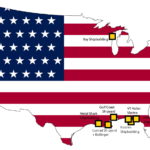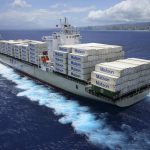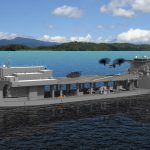The shipbuilding business in the U.S. is full of promise with the changing of the guard in Washington, D.C. By Barry Parker
On the commercial side, participants in the offshore oil business – a one-time hotbed of activity that declined with the[ds_preview] oil price – are more optimistic, have seen better prospects, as the oil price has risen. On the military side, there is fresh talk from the new President, Donald Trump, of a »350 ship Navy« – contrasted with its present complement of 272 vessels.
The business is not easily compartmentalized; there are many overlaps; some yards can handle both newbuilds and repairs. The commercial yards, the main focus here, are also active in doing work for the governmental sectors which includes the Navy and Coast Guard, but also includes numerous state and local entities.
Generally, the shipyard industry is enthusiastic about prospects under Trump. His talk about bolstering the size of the U.S. Navy (a key tenet of security), and his expressions of support for bringing jobs back to the States, where possible, both auger well for employment in the shipbuilding sector. Efforts to enhance the U.S. inland waterway infrastructure (including projects related to locks and dams on the river system) could also boost demand for barges and towboats – which handle domestic cargo flows, and would not be impacted by developments regarding international trade pacts such as TPP and NAFTA.
The two yards building large ocean-going commercial vessels are NASSCO (part of defense contractor General Dynamics), in San Diego, and the Philly Shipyard (previously known as Aker Philadelphia but still majority owned by Aker companies), on the Delaware River – at the site of a one-time naval yard.
These two yards continue to deliver tankers as U.S. owners continue to add to their Jones Act fleets, mainly taking refined products in coastwise trades. The Philly yard is presently building a four vessel series of 50,000 dwt product tankers for American Petroleum Tankers (APT), part of the energy giant Kinder Morgan. In late November 2016, the first vessel, »American Endurance« was delivered to its owners. The vessel design, with an »LNG Ready Level 1« approval from the Classification Society ABS, is similar to the widely used designs for MR tankers in international trades. The Philly yard explains that the APT vessels are, »… based on a proven Hyundai Mipo Dockyards (HMD) design.«
The NASSCO yard, which benefits from a cooperation agreement with S. Korea’s DSME, has 50,000 dwt product tankers on order for Seacor (in a joint venture with financial investor Avista Partners) and for APT, after delivering six vessels for these two owners during 2016. The vessels are described as »LNG-ready«, meaning that they could be converted over to LNG fueled propulsion in the future. NASSCO has also been a long-time participant in vessel construction for the U.S. Navy.
The two yards also are active in the Jones Act containership trades. NASSCO delivered two LNG fueled containerships to TOTE (part of the Saltchuk Group) during 2015 and 2016 – to be used in the Florida/Puerto Rico trades. In August, 2016, NASSCO received a 511mill. $ contract from Matson Navigation Co. Inc. to build two 3,500TEU container/RoRo carriers with garage space for 800 automobiles that will serve the Hawaii trades. Construction is expected to start in 2018, with deliveries in 2019 and mid-2020.
The Philly yard is also building two 3,600TEU with an aggregate cost of 418mill. $ for Matson, with delivery scheduled for 2018. According to the yard, »The new vessels will be equipped with dual fuel engines that have liquefied natural gas (LNG) capability.« As noted in the accompanying article on U.S. taxation, a portion of the funding for these vessels comes from drawdowns of Matson’s Capital Construction Fund (CCF) reserves.
Group of smaller yards
A group of smaller yards is thriving in the U.S. Gulf and Pacific Northwest regions. Eastern Shipbuilding, in the Panhandle region of Florida, has recently been awarded a contract to build an Offshore Patrol Cutter for the U.S Coast Guard for delivery in 2020, but its wide ranging capabilities are evidenced by its list of current projects and recently delivered vessels. Customer Great Lakes Dredge & Dock (GLDD), a leader in harbor deepening/maintenance and beach nourishment projects, will be taking delivery of a trailing suction hopper dredge »Ellis Island«, fashioned as an articulated tug barge, in Spring 2017.
The yard is also building a smaller capacity, Trailing Suction Hopper Dredger with 8,550 cubic yard hold space, to be called »Magdalen«, for Weeks Marine.
Like other yards in the region, it builds for the offshore oil industry. Two Inspection, Maintenance and Repair vessels are under construction for Harvey Gulf Marine. In addition, the yard continues to build inland river tugs for privately held Florida Marine Transporters (moving oil and products particularly on the Gulf Intracoastal Waterway) and has completed a four vessel order for inland river tugs for customer Impala Terminals Colombia. Eastern is also set to build a trio of 4,500 passenger boats for the Staten Island Ferry in New York City.
Harvey Gulf, mentioned above, has made a groundbreaking commitment to LNG fuelling; it is building a series of six dual fueled 302’ OSVs at the Gulf Coast Ship yard, which it acquired in mid-2015. Three vessels have already been delivered while another three will go into service during 2017 and early 2018.
LNG also plays a role in the activities of Conrad Shipyard, another large U.S. Gulf builder and repairer. The yard, active in building tank barges, dry barges and tugs (for Florida Marine and many others), will soon be delivering an LNG bunker barge that will serve the TOTE containership newbuilds mentioned above. In late 2016, the Conrad yard announced the formation of an LNG business unit.
VT Halter Marine, with a group of facilities located in Pascagoula, Mississippi, describes itself as »… the largest designer and builder of small to medium sized ocean-going vessels in the United States.« The yard handles both military and commercial jobs; recent projects include a series of ATBs for Bouchard Transportation’s coastwise refined products business. Bollinger Shipyards maintains multiple facilities throughout Louisiana, performing new construction and repair, for both commercial and government customers. Recent deliveries have included a series of Fast Response Cutters for the U.S. Coast Guard, but also towboats for work on the inland waterways. Versatility is paramount; constructors of small vessels such as Horizon Shipbuilding or Metal Shark may find themselves building ferries (in this case, for New York City) when not building towboats for Florida Marine, or fast response boats for the Coast Guard or local fire departments.
In the Pacific Northwest, Vigor Industrial, a powerhouse which has grown through multiple acquisitions of smaller yards, has recently delivered Articulated Tug Barges (ATBs) for Harley Marine, as well as large passenger vessels for Washington State Ferries. It continues to be active in response boats and small cutters. Its recent customers have included the Harbor Patrol of the New York Police Department and the Fire Department in Portland, Oregon.
In the Great Lakes region, Bay Shipbuilding (a part of Fincantieri), in Sturgeon Bay, Wisconsin builds for both government and commercial customers, having delivered an ATB (6,000 horsepower tug and 155,000 barrel barge) for Kirby Corporation’s fuel barging business in November, 2016; a sister pair will be delivered in Summer, 2017.
Barry Parker






















